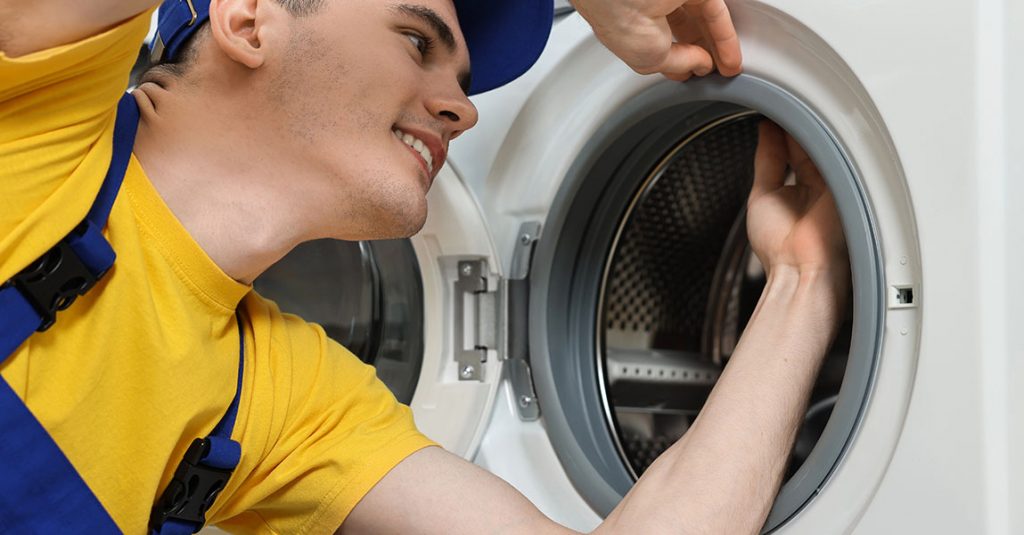Why Front Load Washers Are Prone to Odours
Front load washers are popular for their energy efficiency and gentle washing motion. However, they are also known for developing musty or sour smells over time. That is to say, many homeowners notice an unpleasant odour when opening the washer door. This issue often stems from the unique design of front load machines.
Unlike top loaders, these washers have a watertight rubber gasket that seals the door shut. Consequently, water and detergent residue can become trapped in the folds of this door seal. Over time, this buildup creates the ideal environment for mold, mildew, and bacteria to grow. In addition, high-efficiency detergents sometimes don’t rinse away thoroughly, leaving behind a film that feeds microbial growth.
Our team has found that regular maintenance and proper cleaning techniques can significantly reduce or eliminate this problem. However, ignoring it can result in persistent smells and even damage to your laundry.
The Role of the Door Seal in Washer Odours
The door seal, also known as a gasket, plays a critical role in keeping your washer leak-free. However, this same seal can become a hidden source of foul odours. That is to say, the moisture it retains doesn’t always evaporate between cycles. Consequently, bacteria and mold thrive in that damp environment, especially if the washer is kept closed between uses.
We’ve inspected countless machines at JAY Appliance Repair where the inner folds of the seal were visibly blackened with mildew. In many of these cases, a simple wipe-down wasn’t enough. Instead, deeper cleaning or even seal replacement was necessary. For instance, homeowners sometimes discover chunks of buildup hiding in the crevices of the gasket.
A quick wipe with a cloth won’t fix a deeply embedded issue. To clarify, you may need to peel back the folds of the seal and scrub with a solution of water and vinegar or diluted bleach.
Cleaning Techniques That Actually Work
Most people wipe the visible parts of the washer drum but neglect the gasket area. As a result, their cleaning efforts don’t resolve the root of the smell. That is to say, targeting the seal directly is essential if you want long-lasting freshness. We always recommend pulling the rubber folds gently to access hidden grime.
Subsequently, we use a soft brush with a non-abrasive cleaning solution to scrub the area. For example, vinegar mixed with water helps dissolve detergent scum and kills mildew. After that, it’s important to dry the gasket thoroughly with a towel. Leaving any moisture behind will only restart the problem.
We also tell homeowners to leave the washer door ajar after every cycle. In the same vein, removing laundry promptly helps prevent trapped moisture. When dealing with heavy build-up, it may be wise to get professional appliance repair in Leduc by checking appliance repair services in your area.
Preventing the Smell from Returning
Once the door seal is cleaned, the next step is keeping it that way. Firstly, we suggest using the right amount of detergent. Using too much can leave residue behind. Secondly, avoid fabric softener unless absolutely necessary, as it can coat the drum and seal with waxy buildup. In addition, use the washer’s self-cleaning cycle at least once a month.
Meanwhile, don’t forget to clean the detergent tray and the filter trap regularly. For instance, lint and leftover detergent can affect drainage and cause stagnant water to linger. Similarly, it’s helpful to run an empty hot water cycle with white vinegar or a washer cleaner tablet every few weeks.
Our team at JAY Appliance Repair has observed that consistent maintenance drastically reduces odour complaints. Therefore, being proactive goes a long way. If smells persist even after cleaning, there may be an underlying issue with drainage or airflow that requires expert attention. You can always schedule service or ask questions through our contact form.
When the Gasket Needs to Be Replaced
Sometimes, cleaning just isn’t enough. That is to say, if the door seal is physically damaged or heavily molded, it may be beyond saving. Cracks or tears in the gasket allow water to seep in and get trapped even more deeply. Consequently, replacing the entire seal is the most effective solution.
We’ve replaced many door gaskets where homeowners thought they’d need a new machine. In other words, the smell was so strong that they believed the washer had reached the end of its life. However, a simple gasket replacement brought it back to full functionality. It’s a relatively quick repair when handled by trained professionals.
Moreover, a new gasket improves both cleanliness and sealing performance. If the seal is loose, your washer may even be leaking slightly. Addressing these small issues early helps extend the lifespan of your appliance. For washer maintenance or repairs, it’s worth reaching out to local experts who understand the specific model and layout of your machine.
What Happens If You Ignore the Odour?
At first, a little smell might seem harmless. However, bad odours are often the first sign of mold or bacteria spreading through the washer system. That is to say, this can eventually impact your laundry. Clothes may come out smelling sour even after washing. In addition, the buildup can migrate to internal components, affecting how the machine drains and spins.
Over time, you may notice longer cycle times, standing water in the drum, or error codes. Consequently, what started as a smell becomes a mechanical issue. We’ve seen motors burn out because drainage was blocked by gunk from detergent and mildew. Therefore, ignoring the smell can lead to expensive repairs down the road.
Our team at JAY Appliance Repair always recommends early intervention. Similarly, homeowners should keep a routine cleaning schedule to avoid surprise issues. Odours are more than just a nuisance. They are your washer’s way of telling you something isn’t right.
FAQs
What causes the smell in front load washers?
The smell is usually caused by mold and mildew growing in the rubber door seal, detergent tray, or drain system. Moisture trapped in the seal is a common breeding ground for bacteria.
How often should I clean my washer gasket?
We recommend cleaning it every two weeks, and more frequently if you do a lot of laundry. Regular upkeep helps prevent buildup before it starts.
Can I use bleach to clean the seal?
Yes, but you must dilute it properly. Use a mix of one part bleach to ten parts water and apply it with a cloth or soft brush, then rinse thoroughly.
Is it safe to run an empty cycle with vinegar?
Yes, running a hot water cycle with two cups of white vinegar is a safe and effective way to remove odours and clean internal parts.
When should I replace the washer gasket?
Replace the gasket if you notice cracks, heavy mold that won’t come off, or leaks around the door. These signs indicate that cleaning is no longer enough.

